Practicing Jazz Improvisation
By
Dr. Rik Pfenninger
Saxophone Professor at Plymouth State University
I work with saxophone students of all ages, and the question that I hear most is, “how do I begin to learn to improvise?” While most students understand how to practice an etude or their band music, they really have no idea how to practice and learn jazz improvisation.
Welcome to Practicing Jazz Improvisation. In the lessons that follow, you will learn how to practice jazz improvisation in a systematic, slow, and organized manner. By working through each lesson and practicing the exercises, you will learn techniques to become a great jazz soloist. Even if you have no experience playing jazz, you can learn how to become a great improviser! Please note that I am approaching your improvisation lessons through the jazz genre, but the concepts that you are about to learn apply to all styles of music!
Each lesson will introduce you to a new concept with playing exercises and play-a-long MP3 files so that you can practice along with a rhythm section at all times!
Please feel free to email me at rikp@mac.com if you have any questions. Remember, feedback of any kind is always welcome!
Learning to improvise is fun! Let’s get started.
Rik Pfenninger
Practicing Jazz Improvisation
Lesson 1
Click Here To Download Lesson 1 Files
The files that you just downloaded will be used for this lesson. The folder contains several PDF Files that you may print out and an MP3 Play-a-long file.
The Major Scale
The foundation for our first lesson is the Major Scale. If you don’t know all of your major scales, pick up your horn and start to memorize each scale. In the Lesson 1 File Folder, that you just downloaded, is a Major Scale PDF File. Feel free to print it out and use it for a reference.
Swing Style/Articulation
When you practice your major scales, you are going practice them in a Swing Style.
This is what the swing style articulation looks like:
No two jazz players swing in the same manner. The above articulation works best for achieving a swing style when playing eighth notes:
Click Here
After you have played, and listened to, the Swing Scale movie, memorize your major scales using a swing articulation. Use the Major scale sheet from the Lesson 1 File Folder. Work with a metronome, start at a slow tempo and gradually increase the speed of your metronome. Once you have mastered your major scales with a swing articulation, you are ready for the next step.
The Next Step
Look at your Major Scale Sheet. We are now going to number each scale degree with numbers 1-8. As follows:
For you to be able to improvise, you first need to do some exercises that will help you master chords/scales and allow you to hear chord changes. If you have never played with a rhythm section, don't worry, these exercises will help you become a master improviser!
Next, you are going to print out the file titled Major Chord Changes sheet found in the Lesson 1 File Folder that you downloaded at the start of the lesson. Be sure to download the correct file for your instrument Eb=Alto/Bari sax, Bb=tenor/soprano sax, C=Flute, guitar etc.
Depending on your instrument type, the file should look something like this: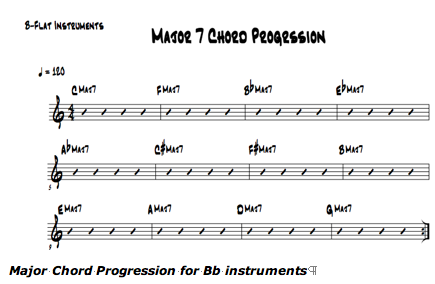
Exercise 1: Playing The Root of Each Chord
Our First Exercise is going to be very easy. Using the Major Chord Changes Sheet and the MP3 Play-a-long titled Major Chord Progression, you are going to begin by just playing the root (1) of each chord. First you will play them as whole notes then you will improvise different rhythms using only the root of the chord.
Listen to the playing example below before you start to work on Exercise 1![]() Exercise 1 Playing Example
Exercise 1 Playing Example
Ok, now it is your turn. Practice just playing and improvising the root of each chord.
Remember to use your major scales to play over Major Chords.
Exercise 2: Playing pattern 12, 12, over each chord.
For exercise 2, we are going to be playing a pattern of 1,2 in eighth notes over each chord. It will look like this:
Play the above pattern over the entire chord progression and then improvise using only the
1,2 1,2 pattern.
Listen to the playing example below before you start to work on Exercise 2![]() Exercise 2 Playing Example
Exercise 2 Playing Example
Ok, now it is your turn!
Remember to use your major scales to play over Major Chords.
Exercise 3: Playing pattern 1232, 1232, over each chord.
For exercise 2, we are going to be playing a pattern of 1232, 1232, in eighth notes over each chord. It will look like this:
Play the above pattern over the entire chord progression and then improvise using only the
1232 pattern.
Listen to the playing example below before you start to work on Exercise 3![]() Exercise 3 Playing Example
Exercise 3 Playing Example
Ok, now it is your turn!
Remember to use your major scales to play over Major Chords.
Exercise 4: Playing pattern 1235, 1235 over each chord.
For exercise 4, we are going to be playing a pattern of 1235, 1235 in eighth notes over each chord. It will look like this:
Play the above pattern over the entire chord progression and then improvise using only the
1235 pattern.
Listen to the playing example below before you start to work on Exercise 4![]() Exercise 4 Playing Example
Exercise 4 Playing Example
Ok, now it is your turn!
Remember to use your major scales to play over Major Chords.
Exercise 5: Playing pattern 1357, 1357 over each chord.
For exercise 5, we are going to be playing a pattern of 1237, 1237 in eighth notes over each chord. It will look like this:
Play the above pattern over the entire chord progression and then improvise using only the
1357 pattern.
Listen to the playing example below before you start to work on Exercise 5![]() Exercise 5 Playing Example
Exercise 5 Playing Example
Ok, now it is your turn!
Remember to use your major scales to play over Major Chords.
Exercise 6: Playing pattern 1357,6543 over each chord.
For exercise 6, we are going to be playing a pattern of 1357, 6543 in eighth notes over each chord. It will look like this:
Play the above pattern over the entire chord progression and then improvise using only the
1357,6543 pattern.
Listen to the playing example below before you start to work on Exercise 6![]() Exercise 6 Playing Example
Exercise 6 Playing Example
Ok, now it is your turn!
Remember to use your major scales to play over Major Chords.
Exercise 7: Playing a Major scale over each chord.
For exercise 7, we are going to be playing a Major scale in eighth notes over each chord. It will look like this:
Play the above scale pattern over the entire chord progression.
Listen to the playing example below before you start to work on Exercise 7![]() Exercise 7 Playing Example.
Exercise 7 Playing Example.
Ok, now it is your turn!
Remember to use your major scales to play over Major Chords.
Exercise 8: Starting To Improvise!
For exercise 8, we are actually going to being to improvise, but...with some restrictions. For this exercise, you are only going to be improvising using Quarter Notes.
Listen to the playing example below before you start to work on Exercise 8![]() Exercise 8 Playing Example
Exercise 8 Playing Example
Ok, now it is your turn!
Remember to use your major scales to play over Major Chords.
Exercise 9: More Improvisation
For exercise 9, we are actually going to being to improvise, but...with some restrictions. For this exercise, you are only going to be improvising using only Eighth Notes.
Listen to the playing example below before you start to work on Exercise 9![]() Exercise 9 Playing Example
Exercise 9 Playing Example
Ok, now it is your turn!
Remember to use your major scales to play over Major Chords.
Exercise 10: Improvise!!
For exercise 10, you can now improvise with no restrictions! Remember to keep it simple and know at all times where you are in the changes. You don’t need to play every note in the major scale for every chord! Also note that the 4th scale degree in the major scale does not sound good if you just sit on that note. I call it an Avoid Note. It is ok to play the fourth scale degree in a line, but don’t sit on that note. The tritone does not sound good: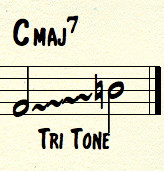
Listen to the playing example below before you start to work on Exercise 9
I have kept my improvisation very simple, but you can still hear me making the changes.
That is what you ALWAYS want to strive for in your improvisations.![]() Exercise 10 Playing Example
Exercise 10 Playing Example
Ok, now it is your turn!
Remember to use your major scales to play over Major Chords. improvise! Have fun!
Recap:
For this lesson, you have now mastered the Major scale and Major chords. This is a starting point!
For our next lesson we will be moving on to Minor Chords and the Dorian Scale
This Concludes Lesson 1
Practicing Jazz Improvisation
Lesson 2
Click Here To Download Lesson 2 Files
The files that you just downloaded will be used for this lesson. The folder contains several PDF Files that you may print out and an MP3 Play-a-long file.
The Mixolydian Scale
Now that you have mastered your major scales, it is time to start learning the major modes. For this lesson we are going to learn the Mixolydian scale. This is one scale that can be used when improvising over a Dominant 7 chord.
The Dominant 7th Chord
To construct a Dominant 7 chord, number the notes in a major scale:
Now lower the 7th scale degree 1/2 step from B to Bb
If we take the 1, 3, 5, b7 and play them on piano at the same time, we will be sounding a
Dominant 7 chord. The symbol for a Dominant 7 chord is 7
If a pianist sees the chord symbol C7, he/she will play the following chord:
Building a Mixolydian Scale
It is important to remember that the Mixolydian scale (or mode) is part of the Major Mode family. If we take any Major scale and play from the 5th note of that scale stepwise up to an octave, we will be playing a Mixolydian scale.
If we start on the 5th note (G) of the C Major scale, we will be playing a scale from G to G in the key of C Major or the G Mixolydian scale!
This is called the G Mixolydian scale because it starts and ends on G and is in the key of C Major.
Notice that our b7 from the Dominant 7 chord is built right into our scale.
Tip! The most important thing to remember is that although we are playing a G
Mixolydian scale, we are still playing in the key of C Major!
In the first example, a C Mixolydian scale, we are playing in the key of F Major!
This is an important concept to remember as we begin to study the Major Modes.
Look at the Mixolydian Scale Sheet that you downloaded at the beginning of this lesson.
I have written out each Mixolydian scale along with the Major key they are derived from.
So when you start to memorize the Mixolydian scales, you are really just playing a Major scale
starting on the 5th note of each Major scale. There is no new tonal material to learn. This concept of
key will become more and more important as we move further along in our study of
jazz improvisation.
When I see a C7 chord symbol, I am improvising in the key of F Major! I am playing an
F Major scale starting on C or a C Mixolydian scale Just like in the first example!
The Next Step
Look at your Mixolydian Scale Sheet. You are now going to number each scale degree just like you did for lesson 1. A lot of the scale exercises will be very similar to exercise one. I am only introducing one new note here, the b7!
Next, you are going to print out the file titled Dom 7 Chord Changes
found in the Lesson 2 File Folder that you downloaded at the start of the lesson. Be sure to download the correct file for your instrument Eb=Alto/Bari sax, Bb=tenor/soprano sax, C=Flute, guitar etc. Just like you did for lesson 1.
Exercise 1: Playing The Root of Each Chord
You know the routine! Just like in Lesson 1, we are going to start by playing the root of each chord. This will get the sound of the progression in your head and under your fingers!
Using the Dom 7 Changes Sheet and the MP3 Play-a-long titled Dom 7 Chord Progression, you are going to begin by just playing the root (1) of each chord. First you will play them as whole notes then you will improvise different rhythms using only the root of the chord.
Exercise 2: Playing pattern 12, 12, over each chord.
For exercise 2, we are going to be playing a pattern of 1,2 in eighth notes over each chord. It will look like this:
Play the above pattern over the entire chord progression and then improvise using only the
1,2 1,2 pattern. After you have done the pattern, improvise using only those notes from the
pattern.
Exercise 3: Playing pattern 1232, 1232, over each chord.
For exercise 2, we are going to be playing a pattern of 1232, 1232, in eighth notes over each chord. It will look like this:
Play the above pattern over the entire chord progression and then improvise using only the
1232 pattern. After you have done the pattern, improvise using only those notes from the
pattern.
Exercise 4: Playing pattern 1235, 1235 over each chord.
For exercise 4, we are going to be playing a pattern of 1235, 1235 in eighth notes over each chord. It will look like this:
Play the above pattern over the entire chord progression and then improvise using only the
1235 pattern. After you have done the pattern, improvise using only those notes from the
pattern.
Exercise 5: Playing pattern 135b7, 135b7 over each chord.
For exercise 5, we are going to be playing a pattern of 135b7, 135b7 in eighth notes over each chord. It will look like this:
Play the above pattern over the entire chord progression and then improvise using only the
135b7 pattern. After you have done the pattern, improvise using only those notes from the
pattern.
Exercise 6: Playing pattern 135b7,6543 over each chord.
For exercise 6, we are going to be playing a pattern of 135b7, 6543 in eighth notes over each chord. It will look like this:
Play the above pattern over the entire chord progression and then improvise using only the
135b7,6543 pattern. After you have done the pattern, improvise using only those notes from the
pattern.
Exercise 7: Playing a Mixolydian scale over each chord.
For exercise 7, we are going to be playing a Mixolydian scale in eighth notes over each chord. It will look like this:
Play the above scale pattern over the entire chord progression.
Exercise 8: Starting To Improvise!
For exercise 8, we are actually going to being to improvise, but...with some restrictions. For this exercise, you are only going to be improvising using Quarter Notes.
Exercise 9: More Improvisation
For exercise 9, we are actually going to being to improvise, but...with some restrictions. For this exercise, you are only going to be improvising using only Eighth Notes.
Exercise 10: Improvise!!
For exercise 10, you can now improvise with no restrictions! Remember to keep it simple and know at all times where you are in the changes. You don’t need to play every note in the Mixolydian scale for every chord! Also, be thinking about the key that you are playing in! This is VERY important, especially when we start moving ahead to other lessons!
Real Book Tunes
Get to The Real Book I Sixth Edition (Available on Amazon) and look at the following tunes:
Straight No Chaser Pg. 386
Sweet Georgia Bright Pg. 395
Freddie Freeloader Pg. 151
These tunes contain only Dom 7th chords. Go through each tune using the exercises from lessons 1 and 2. Memorize the head and the changes.
Real Book Play-a-Longs and Analysis Files (click on the links below:
Lady Bird: Volume Six Pg. 235
Killer Joe: Volume Six
This Concludes Lesson 2
Practicing Jazz Improvisation
Lesson 3
Click Here To Download Lesson 3 Files
The files that you just downloaded will be used for this lesson. The folder contains several PDF Files that you may print out and an MP3 Play-a-long file.
The Dorian Scale
For our next lesson we are going to learn the Dorian scale. This is one scale that can be used when improvising over a minor 7 chord.
The Minor 7th Chord
To construct a Minor 7 chord, number the notes in a major scale:
Now lower the 3rd and 7th scale degrees 1/2 step.
If we take the 1, b3, 5, b7 and play them on piano at the same time, we will be sounding a
minor 7 chord. The symbol for a minor 7 chord is m7, min7, -7
If a pianist sees the chord symbol C-7, he/she will play the following chord: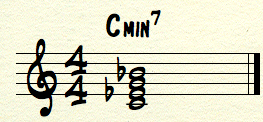
Building a Dorian Scale
It is important to remember that the Dorian Scale (or mode) is part of the Major Mode family. If we take any Major scale and play from the 2nd note of that scale stepwise up to an octave, we will be playing a Dorian scale.
If we start on the 2nd note (D) of the C Major scale, we will be playing a scale from D to D in the key of C Major or the D Dorian scale!
This is called the D Dorian scale because it starts and ends on D and is in the key of C Major.
Notice that our b3 and b7 from the Minor 7 chord is built right into our scale.
Tip! The most important thing to remember is that although we are playing a D
Dorian scale, we are still playing in the key of C Major!
In the first example, a C Dorian scale, we are really playing in the key of Bb Major!
This is an important concept to remember as we begin to study the Major Modes.
Look at the Dorian Scale Sheet that you downloaded at the beginning of this lesson.
I have written out each Dorian scale along with the Major key they are derived from.
So when you start to memorize the Dorian scales, you are really just playing a Major scale
starting on the 2nd note of each Major scale. There is no new tonal material to learn. This concept of
key will become more and more important as we move further along in our study of
jazz improvisation.
When I see a C-7 chord symbol, I am improvising in the key of Bb Major! I am playing a
Bb Major scale starting on C or a C Dorian scale Just like in the first example!
The Next Step
Look at your Dorian Scale Sheet. You are now going to number each scale degree just like you did for lesson 1. A lot of the scale exercises will be very similar to Lesson two. I am only introducing one new note here, the b3 (you were already playing the b7 from the Mixolydian mode)!
Next, you are going to print out the file titled Minor 7 Chord Changes
found in the Lesson 3 File Folder that you downloaded at the start of the lesson. Be sure to download the correct file for your instrument Eb=Alto/Bari sax, Bb=tenor/soprano sax, C=Flute, guitar etc. Just like you did for the previous lessons.
Exercise 1: Playing The Root of Each Chord
You know the routine! Just like in Lesson 1, we are going to start by playing the root of each chord. This will get the sound of the progression in your head and under your fingers! Remember that you will be using the Dorian Scale for all of the following exercises.
Using the Minor 7 Changes Sheet and the MP3 Play-a-long titled Minor 7 Chord Progression, you are going to begin by just playing the root (1) of each chord. First you will play them as whole notes then you will improvise different rhythms using only the root of the chord.
Exercise 2: Playing pattern 12, 12, over each chord.
For exercise 2, we are going to be playing a pattern of 1,2 in eighth notes over each chord. It will look like this:
Exercise 3: Playing pattern 1232, 1232, over each chord.
For exercise 2, we are going to be playing a pattern of 1232, 1232, in eighth notes over each chord. It will look like this:
Play the above pattern over the entire chord progression and then improvise using only the
1232 pattern. After you have done the pattern, improvise using only those notes from the
pattern.
Exercise 4: Playing pattern 1235, 1235 over each chord.
For exercise 4, we are going to be playing a pattern of 1235, 1235 in eighth notes over each chord. It will look like this:
Play the above pattern over the entire chord progression and then improvise using only the
1235 pattern. After you have done the pattern, improvise using only those notes from the
pattern.
Exercise 5: Playing pattern 1357, 1357 over each chord.
For exercise 5, we are going to be playing a pattern of 1357, 1357 in eighth notes over each chord. It will look like this:
Play the above pattern over the entire chord progression and then improvise using only the
1357 pattern. After you have done the pattern, improvise using only those notes from the
pattern.
Exercise 6: Playing pattern 1357,6543 over each chord.
For exercise 6, we are going to be playing a pattern of 1357, 6543 in eighth notes over each chord. It will look like this:
Play the above pattern over the entire chord progression and then improvise using only the
1357,6543 pattern. After you have done the pattern, improvise using only those notes from the
pattern.
Exercise 7: Playing a Dorian scale over each chord.
For exercise 7, we are going to be playing a Dorian scale in eighth notes over each chord. It will look like this:
Play the above scale pattern over the entire chord progression.
Exercise 8: Starting To Improvise!
For exercise 8, we are actually going to being to improvise, but...with some restrictions. For this exercise, you are only going to be improvising using Quarter Notes.
Exercise 9: More Improvisation
For exercise 9, we are actually going to being to improvise, but...with some restrictions. For this exercise, you are only going to be improvising using only Eighth Notes.
Exercise 10: Improvise!!
For exercise 10, you can now improvise with no restrictions! Remember to keep it simple and know at all times where you are in the changes. You don’t need to play every note in the Dorian scale for every chord! Also, be thinking about the key that you are playing in! This is VERY important, especially when we start moving ahead to other lessons!
Real Book Tunes
Get The Real Book I Sixth Edition (Available on Amazon) and look at the following tunes:
Impressions Pg. 205
So What Pg. 364. *play the changes at the bottom of 365.
These tunes contain only Minor 7th chords. Go through each tune using the exercises from lessons 1 and 2. Memorize the head and the changes.
This Concludes Lesson 3
Practicing Jazz Improvisation
Lesson 4
Click Here To Download Lesson 4 Files
The files that you just downloaded will be used for this lesson. The folder contains several PDF Files that you may print out and an MP3 Play-a-long file.
Combining Chords-The ii-V-I Progression
You should now be familiar with Major 7 Chords, Dominant 7 Chords, and Minor 7 Chords. We are now going to combine each of those chords into a single chord progression known in jazz as the ii-V-I Progression. This is a VERY common progression found in jazz and popular music. Once you have mastered the ii-V-I progression, you are well on your way to becoming a good improvisor!
Constructing ii-V-I Progressions
If we construct diatonic 7th chords using the 2nd, 5th, and 1st note of a C Major scale, we will have the following three chords: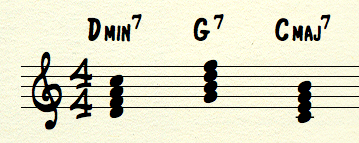
If you look at all three chords and the scales for those chords, you will notice
that all three chords share the common tonality of C Major. You can improvise
using a C Major scale for all three chords! We have just taken three chord
types and reduced them to one scale! How cool is that?
If you look at your ii-V-I progressions that you downloaded for this lesson, notice that
I have indicated what key you are playing in for each progression. An easy way
to determine the key is to look at the I chord! That is the key/scale that you
will be using for the ii-V-I progression.
Assignment!
Use the exercises from the previous lessons and apply them to the ii-V-I progressions, using the play-a-long to practice with. Make sure that you master every key!
Start to go through your Real Book and identify any and all ii-V-I progressions. There are a ton! It is by far the most popular chord progression in tonal music!
Real Book Tunes
Get The Real Book I Sixth Edition (Available on Amazon) and look at the following tunes:
Tune Up Pg. 418
Lady Bird Pg. 235
Also note that I have provided a chord/key analysis for Tune Up and Lady Bird in the Lesson 4 download files. Study them and remember to think about what key you are playing in at all times!
These tunes contain ii-V-I progressions. Go through each tune using the exercises from lessons 1 and 2. Memorize the head and the changes.
This Concludes Lesson 4
Practicing Jazz Improvisation
Lesson 5
Click Here To Download Lesson 5 Files
The files that you just downloaded will be used for this lesson. The folder contains several PDF Files that you may print out and an MP3 Play-a-long file.
The Locrian Scale
For our next lesson we are going to learn the Locrian scale. This is one scale that can be used when improvising over a half-diminished 7th chord. This half-diminished 7th chord can be notated two ways:![]()
![]()
The half-diminished 7th or minor b5 chord (both mean the same thing)
To construct a half-diminished chord, we are going to start on the 7th scale degree of a major scale and play up one octave. We will be creating a Locrian scale. In this case I am starting on the 7th scale degree of a C major scale, as notated below, and playing from B to B up one octave:
If we combine the 1, 3rd, 5th and 7th notes of the above Locrian scale we will now have
constructed a half-diminished or minor b5 7th chord: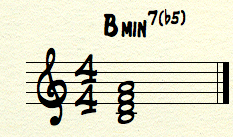
Notice that this chord is very similar to a minor chord, except that the 5th is now
lowered 1/2 step. Let’s compare the two chords: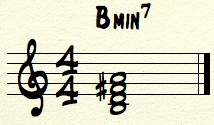
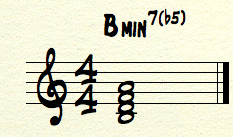
The 5th of the minor 7 chord (F#) is lowered 1/2 step to (F) for the
minor 7 b5 chord.
Building a Locrian Scale
It is important to remember that the Locrian Scale (or mode) is part of the Major Mode family. If we take any Major scale and play from the 7th note of that scale stepwise up to an octave, we will be playing a Locrian scale.
If we start on the 7th note (B) of the C Major scale, we will be playing a scale from B to B in the key of C Major or the B Locrian scale!
This is called the B Locrian scale because it starts and ends on B and is in the key of C Major.
Notice that our Minor 7b5 or half-diminished chord is built right into our scale.
Tip! The most important thing to remember is that although we are playing a B Locrian scale, we are still playing in the key of C Major!
Look at the Locrian Scale Sheet that you downloaded at the beginning of this lesson.
I have written out each Locrian scale along with the Major key they are derived from.
So when you start to memorize the Locrian scales, you are really just playing a Major scale
starting on the 7th note of each Major scale. There is no new tonal material to learn. This concept of
key will become more and more important as we move further along in our study of
jazz improvisation.
When I see a Bm7b5 chord symbol, I am improvising in the key of C Major! I am playing a C Major scale starting on B or a B Locrian scale Just like in our example!
The Next Step
Look at your Locrian Scale Sheet. You are now going to number each scale degree just like you did for lesson 1. A lot of the scale exercises will be very similar to your previous lessons.
Next, you are going to print out the file titled 7b5 Chord Changes
found in the Lesson 5 File Folder that you downloaded at the start of the lesson. Be sure to download the correct file for your instrument Eb=Alto/Bari sax, Bb=tenor/soprano sax, C=Flute, guitar etc. Just like you did for the previous lessons.
Exercise 1: Playing The Root of Each Chord
You know the routine! Just like in Lesson 1, we are going to start by playing the root of each chord. This will get the sound of the progression in your head and under your fingers! Remember that you will be using the Locrian Scale for all of the following exercises.
Using the 7b5 Changes Sheet and the MP3 Play-a-long titled 7b5 Chord Progression, you are going to begin by just playing the root (1) of each chord. First you will play them as whole notes then you will improvise different rhythms using only the root of the chord.
Exercise 2: Playing pattern 12, 12, over each chord.
For exercise 2, we are going to be playing a pattern of 1,2 in eighth notes over each chord. It will look like this:
Exercise 3: Playing pattern 1232, 1232, over each chord.
For exercise 2, we are going to be playing a pattern of 1232, 1232, in eighth notes over each chord. It will look like this:
Play the above pattern over the entire chord progression and then improvise using only the
1232 pattern. After you have done the pattern, improvise using only those notes from the
pattern.
Exercise 4: Playing pattern 1235, 1235 over each chord.
For exercise 4, we are going to be playing a pattern of 1235, 1235 in eighth notes over each chord. It will look like this:
Play the above pattern over the entire chord progression and then improvise using only the
1235 pattern. After you have done the pattern, improvise using only those notes from the
pattern.
Exercise 5: Playing pattern 1357, 1357 over each chord.
For exercise 5, we are going to be playing a pattern of 1357, 1357 in eighth notes over each chord. It will look like this:
Play the above pattern over the entire chord progression and then improvise using only the
1357 pattern. After you have done the pattern, improvise using only those notes from the
pattern.
Exercise 6: Playing pattern 1357,6543 over each chord.
For exercise 6, we are going to be playing a pattern of 1357, 6543 in eighth notes over each chord. It will look like this:
Play the above pattern over the entire chord progression and then improvise using only the
1357,6543 pattern. After you have done the pattern, improvise using only those notes from the
pattern.
Exercise 7: Playing a Locrian scale over each chord.
For exercise 7, we are going to be playing a Locrian scale in eighth notes over each chord. It will look like this:
Play the above scale pattern over the entire chord progression.
Exercise 8: Starting To Improvise!
For exercise 8, we are actually going to being to improvise, but...with some restrictions. For this exercise, you are only going to be improvising using Quarter Notes.
Exercise 9: More Improvisation
For exercise 9, we are actually going to being to improvise, but...with some restrictions. For this exercise, you are only going to be improvising using only Eighth Notes.
Exercise 10: Improvise!!
For exercise 10, you can now improvise with no restrictions! Remember to keep it simple and know at all times where you are in the changes. You don’t need to play every note in the Locrian scale for every chord! Also, be thinking about the key that you are playing in! This is VERY important, especially when we start moving ahead to other lessons!
Real Book Tunes
Get The Real Book I Sixth Edition (Available on Amazon) and look at the following tune:
Autumn Leaves Pg. 39
Note that there is a B7b9 chord in a couple of places, for now, just play it as a B7. We will learn b9 chords later! Or you may play the following scale over that chord:
This Concludes Lesson 5
Practicing Jazz Improvisation
Lesson 6
Click Here To Download Lesson 6 Files
The files that you just downloaded will be used for this lesson. The folder contains several PDF Files that you may print out and an MP3 Play-a-long file.
The Phrygian Scale
For this lesson we are going to learn the Phrygian scale. This is one scale that can be used when improvising over a 7sus (b9) chord. This chord is notated as follows:
The 7sus (b9) Chord
To construct a 7sus (b9) chord, we are going to start on the 3rd scale degree of a major scale and play up one octave. We will be creating a Phrygian scale. In this case I am starting on the 3rd scale degree of a C major scale, as notated below, and playing from E to E up one octave:
If we combine the 1, 4th, 5th and 7th and 2nd (9th) notes of the above Phrygian scale we will now have
constructed an 7sus(b9) chord: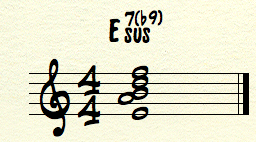
Building a Phrygian Scale
It is important to remember that the Phrygian Scale (or mode) is part of the Major Mode family. If we take any Major scale and play from the 3rd note of that scale stepwise up to an octave, we will be playing a Phrygian scale.
If we start on the 3rd note (E) of the C Major scale, we will be playing a scale from E to E in the key of C Major or the E Phrygian scale! This scale may sound a little strange to your ears because it starts with a 1/2 step interval. 
Tip! The most important thing to remember is that although we are playing an E Phrygian scale, we are still playing in the key of C Major!
Look at the Phrygian Scale Sheet that you downloaded at the beginning of this lesson.
I have written out each Phrygian scale along with the Major key they are derived from.
So when you start to memorize the Phrygian scales, you are really just playing a Major scale
starting on the 3rd note of each Major scale. There is no new tonal material to learn. This concept of
key will become more and more important as we move further along in our study of
jazz improvisation.
When I see an E7sus(b9) chord symbol, I am improvising in the key of C Major! I am playing aC Major scale starting on E or an E Phrygian scale Just like in our example!
The Next Step
Look at your Phrygian Scale Sheet. You are now going to number each scale degree just like you did for lesson 1. A lot of the scale exercises will be very similar to your previous lessons.
Next, you are going to print out the file titled 7sus(b9) Chord Changes found in the Lesson 6 File Folder that you downloaded at the start of the lesson. Be sure to download the correct file for your instrument Eb=Alto/Bari sax, Bb=tenor/soprano sax, C=Flute, guitar etc. Just like you did for the previous lessons.
Exercise 1: Playing The Root of Each Chord
You know the routine! Just like in Lesson 1, we are going to start by playing the root of each chord. This will get the sound of the progression in your head and under your fingers! Remember that you will be using the Phrygian Scale for all of the following exercises.
Using the 7sus(b9) Changes Sheet and the MP3 Play-a-long titled 7sus(b9) Chord Progression, you are going to begin by just playing the root (1) of each chord. First you will play them as whole notes then you will improvise different rhythms using only the root of the chord.
Exercise 2: Playing pattern 12, 12, over each chord.
For exercise 2, we are going to be playing a pattern of 1,2 in eighth notes over each chord. It will look like this:
Exercise 3: Playing pattern 1242, 1242, over each chord.
* Note that this exercise will be somewhat different. We are going to be playing 1, 2, 4, 2 and avoid the 3rd note of the scale since this chord is a Sus Chord and does not contain the 3rd note of the chord.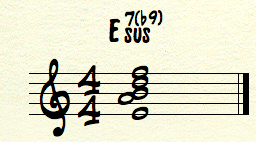
While it is OK to use the 3rd note of a Phrygian scale in your improvisations, don’t sit on that note!
It is much better to land on the 4th (sus) of the chord.
Our pattern will look like this:
Play the above pattern over the entire chord progression and then improvise using only the
1242 pattern. After you have done the pattern, improvise using only those notes from the
pattern.
Exercise 4: Playing pattern 1245, 1245 over each chord.
For exercise 4, we are going to be playing a pattern of 1245, 1245 in eighth notes over each chord. It will look like this:
Play the above pattern over the entire chord progression and then improvise using only the
1245 pattern. After you have done the pattern, improvise using only those notes from the
pattern.
Exercise 5: Playing pattern 1457, 1457 over each chord.
For exercise 5, we are going to be playing a pattern of 1457, 1457 in eighth notes over each chord. It will look like this:
Play the above pattern over the entire chord progression and then improvise using only the
1457 pattern. After you have done the pattern, improvise using only those notes from the
pattern.
Exercise 6: Playing pattern 1457,9754 over each chord.
For exercise 6, we are going to be playing a pattern of 1457, 9754 in eighth notes over each chord. It will look like this:
Play the above pattern over the entire chord progression and then improvise using only the
1457,9754 pattern. After you have done the pattern, improvise using only those notes from the
pattern.
Exercise 7: Playing a Phrygian scale over each chord.
For exercise 7, we are going to be playing a Phrygian scale in eighth notes over each chord. It will look like this:
Play the above scale pattern over the entire chord progression.
Exercise 8: Starting To Improvise!
For exercise 8, we are actually going to being to improvise, but...with some restrictions. For this exercise, you are only going to be improvising using Quarter Notes.
Exercise 9: More Improvisation
For exercise 9, we are actually going to being to improvise, but...with some restrictions. For this exercise, you are only going to be improvising using only Eighth Notes.
Exercise 10: Improvise!!
For exercise 10, you can now improvise with no restrictions! Remember to keep it simple and know at all times where you are in the changes. You don’t need to play every note in the Phrygian scale for every chord! Remember to not sit on the 3rd note of the scale as it is not a chord tone. The fourth is a much better resting place! Also, be thinking about the key that you are playing in! This is VERY important, especially when we start moving ahead to other lessons!
This Concludes Lesson 6
Practicing Jazz Improvisation
Lesson 7
![]() To Lessons Page
To Lessons Page
Click Here To Download Lesson 7 Files
The files that you just downloaded will be used for this lesson. The folder contains several PDF Files that you may print out and an MP3 Play-a-long file.
The Lydian Scale
For our next lesson we are going to learn the Lydian scale. This is one scale that can be used when improvising over a Major 7 #11 chord. This chord can be notated as follows:
The #11 is a new concept for us. In jazz, we often use upper extensions that extend above the 7th of a chord.
Most commonly, we use the 9, 11, and 13. If you were to number your C Major scale again and go beyond the
octave, to the 15th you would have the following:
We stop extending the chord at the 13th because the 14th and 15th really function as the 7th and Root of the chord
we are extending.
If we construct a C chord using the 1, 3, 5, 7, 9, 11, 13. We would have the following chord: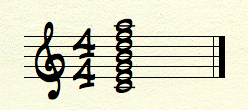
In the case of our C Major 7 #11 the chord would look like this (notice that the 9th is also included):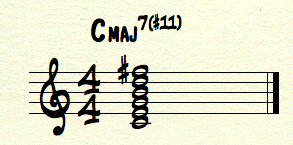
Also notice that this is a Major 7th chord (no b7).
Building a Lydian Scale
It is important to remember that the Lydian Scale (or mode) is part of the Major Mode family. If we take any Major scale and play from the 4th note of that scale stepwise up to an octave, we will be playing a Lydian scale.
If we start on the 4th note (F) of the C Major scale, we will be playing a scale from F to F in the key of C Major or the F Lydian scale!
This is called the F Lydian scale because it starts and ends on F and is in the key of C Major.
Notice that our F Maj7 #11 chord is built right into our scale. 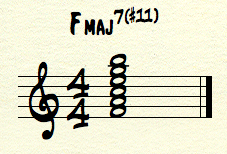
Tip! The most important thing to remember is that although we are playing a F Lydian scale, we are still playing in the key of C Major!
Look at the Lydian Scale Sheet that you downloaded at the beginning of this lesson.
I have written out each Lydian scale along with the Major key they are derived from.
So when you start to memorize the Lydian scales, you are really just playing a Major scale
starting on the 4th note of each Major scale. There is no new tonal material to learn. This concept of
key will become more and more important as we move further along in our study of
jazz improvisation.
When I see a F Maj7(#11) chord symbol, I am improvising in the key of C Major! I am playing a C Major scale starting on F or a F Lydian scale Just like in our example!
The Next Step
Look at your Lydian Scale Sheet. You are now going to number each scale degree just like you did for lesson 1. A lot of the scale exercises will be very similar to your previous lessons.
Next, you are going to print out the file titled Maj7 #11 Chord Changes
found in the Lesson 7 File Folder that you downloaded at the start of the lesson. Be sure to download the correct file for your instrument Eb=Alto/Bari sax, Bb=tenor/soprano sax, C=Flute, guitar etc. Just like you did for the previous lessons.
Exercise 1: Playing The Root of Each Chord
You know the routine! Just like in Lesson 1, we are going to start by playing the root of each chord. This will get the sound of the progression in your head and under your fingers! Remember that you will be using the Lydian Scale for all of the following exercises.
Using the Maj7#11 Changes Sheet and the MP3 Play-a-long titled Maj7 #11 Chord Progression, you are going to begin by just playing the root (1) of each chord. First you will play them as whole notes then you will improvise different rhythms using only the root of the chord.
Exercise 2: Playing pattern 12, 12, over each chord.
For exercise 2, we are going to be playing a pattern of 1,2 in eighth notes over each chord. It will look like this:
Exercise 3: Playing pattern 1232, 1232, over each chord.
For exercise 2, we are going to be playing a pattern of 1232, 1232, in eighth notes over each chord. It will look like this:
Play the above pattern over the entire chord progression and then improvise using only the
1232 pattern. After you have done the pattern, improvise using only those notes from the
pattern.
Exercise 4: Playing pattern 1235, 1235 over each chord.
For exercise 4, we are going to be playing a pattern of 1235, 1235 in eighth notes over each chord. It will look like this:
Play the above pattern over the entire chord progression and then improvise using only the
1235 pattern. After you have done the pattern, improvise using only those notes from the
pattern.
Exercise 5: Playing pattern 579#11, 579#11 over each chord.
For exercise 5, we are going to be playing a pattern of 579#11, in eighth notes over each chord. It will look like this: This will allow us to play the #11 over the chord!
Play the above pattern over the entire chord progression and then improvise using only the
579#11 pattern. After you have done the pattern, improvise using only those notes from the
pattern.
Exercise 6: Playing pattern 1357,6543 over each chord.
For exercise 6, we are going to be playing a pattern of 1357, 6543 in eighth notes over each chord. It will look like this:
Play the above pattern over the entire chord progression and then improvise using only the
1357,6543 pattern. After you have done the pattern, improvise using only those notes from the
pattern.
Exercise 7: Playing a Lydian scale over each chord.
For exercise 7, we are going to be playing a Lydian scale in eighth notes over each chord. It will look like this:
Play the above scale pattern over the entire chord progression.
Exercise 8: Starting To Improvise!
For exercise 8, we are actually going to being to improvise, but...with some restrictions. For this exercise, you are only going to be improvising using Quarter Notes.
Exercise 9: More Improvisation
For exercise 9, we are actually going to being to improvise, but...with some restrictions. For this exercise, you are only going to be improvising using only Eighth Notes.
Exercise 10: Improvise!!
For exercise 10, you can now improvise with no restrictions! Remember to keep it simple and know at all times where you are in the changes. You don’t need to play every note in the Lydian scale for every chord! Also, be thinking about the key that you are playing in! This is VERY important, especially when we start moving ahead to other lessons!
This Concludes Lesson 7
Practicing Jazz Improvisation
Lesson 8
Click Here To Download Lesson 8 Files
The files that you just downloaded will be used for this lesson. The folder contains several PDF Files that you may print out and an MP3 Play-a-long file.
The Mixolydian Scale and 7 Sus Chords
For our next lesson we are going to revisit the Mixolydian scale. We have already used this scale for Dominant 7 chords. For this lesson we are going to revisit this scale for use over the 7sus chord which is notated as follows:

The Mixolydian Scale (again)
As you may remember, to construct a Mixolydian Scale, we are going to start on the 5th scale degree of a major scale and play up one octave. We will be creating a Mixolydian scale. In this case I am starting on the 5th scale degree of a C major scale, as notated below, and playing from G to G up one octave:
If we combine the 1, 4th, 5th and 7th notes of the above Mixolydian scale we will now have
constructed a 7 sus chord: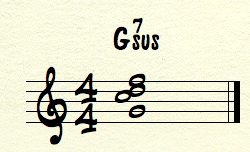
Notice that this chord is very similar to our Dominant 7 chord, except that the 4th is now replacing the
3rd of our Dominant 7 chord. Let’s compare the two chords: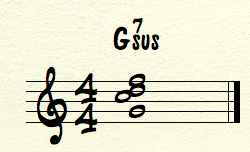
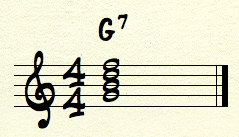
In in a 7 sus chord there is no third. The chord contains the root, 4th, 5th and 7th scale degree of
our Mixolydian scale.
Building a Mixolydian Scale
It is important to remember that the Mixolydian Scale (or mode) is part of the Major Mode family. If we take any Major scale and play from the 5th note of that scale stepwise up to an octave, we will be playing a Mixolydian scale.
If we start on the 5th note (G) of the C Major scale, we will be playing a scale from G to G in the key of C Major or the G Mixolydian scale!
This is called the G Mixolydian scale because it starts and ends on G and is in the key of C Major.
Notice that our 7 sus chord is built right into our scale.
Tip! The most important thing to remember is that although we are playing a G Mixolydian scale, we are still playing in the key of C Major!
** When using the Mixolydian scale over a 7 sus chord, we are going to avoid playing the 3rd note of the scale since it is not present in the
7 sus chord. I am going to call this an “Avoid Note”. 
Look at the Sus 7Mixolydian Scale Sheet that you downloaded at the beginning of this lesson.
I have written out each Mixolydian scale along with the Major key they are derived from.
So when you start to memorize the Misolydian scales, you are really just playing a Major scale
starting on the 5th note of each Major scale. There is no new tonal material to learn. You can still
play the 3rd note of the scale but try to avoid that note while improvising! This concept of
key will become more and more important as we move further along in our study of
jazz improvisation.
When I see a Bm7b5 chord symbol, I am improvising in the key of C Major! I am playing a C Major scale starting on B or a B Locrian scale Just like in our example!
The Next Step
Look at your Mixoydian Scale Sheet. You are now going to number each scale degree just like you did for lesson 1. A lot of the scale exercises will be very similar to your previous lessons.
Next, you are going to print out the file titled 7 Sus Chord Changes
found in the Lesson 8 File Folder that you downloaded at the start of the lesson. Be sure to download the correct file for your instrument Eb=Alto/Bari sax, Bb=tenor/soprano sax, C=Flute, guitar etc. Just like you did for the previous lessons.
Exercise 1: Playing The Root of Each Chord
You know the routine! Just like in Lesson 1, we are going to start by playing the root of each chord. This will get the sound of the progression in your head and under your fingers! Remember that you will be using the Mixolydian Scale for all of the following exercises.
Using the 7 Sus Changes Sheet and the MP3 Play-a-long titled 7 Sus Chord Progression, you are going to begin by just playing the root (1) of each chord. First you will play them as whole notes then you will improvise different rhythms using only the root of the chord.
Exercise 2: Playing pattern 12, 12, over each chord.
For exercise 2, we are going to be playing a pattern of 1,2 in eighth notes over each chord. It will look like this:
Exercise 3: Playing pattern 1242, 1242, over each chord.
For exercise 2, we are going to be playing a pattern of 1242, 1242, in eighth notes over each chord. It will look like this:
Play the above pattern over the entire chord progression and then improvise using only the
1242 pattern. After you have done the pattern, improvise using only those notes from the
pattern.
Exercise 4: Playing pattern 1245, 1245 over each chord.
For exercise 4, we are going to be playing a pattern of 1245, 1245 in eighth notes over each chord. It will look like this:
Play the above pattern over the entire chord progression and then improvise using only the
1245 pattern. After you have done the pattern, improvise using only those notes from the
pattern.
Exercise 5: Playing pattern 1457, 1457 over each chord.
For exercise 5, we are going to be playing a pattern of 1457, 1457 in eighth notes over each chord. It will look like this:
Play the above pattern over the entire chord progression and then improvise using only the
1457 pattern. After you have done the pattern, improvise using only those notes from the
pattern.
Exercise 6: Playing pattern 1457,654 over each chord.
For exercise 6, we are going to be playing a pattern of 1357, 654 in eighth notes over each chord. It will look like this:
Play the above pattern over the entire chord progression and then improvise using only the
1357,654 pattern. After you have done the pattern, improvise using only those notes from the
pattern.
Exercise 7: Playing a Mixolydian scale over each chord.
For exercise 7, we are going to be playing a Mixolydian scale in eighth notes over each chord. It will look like this:
Play the above scale pattern over the entire chord progression.
Exercise 8: Starting To Improvise!
For exercise 8, we are actually going to being to improvise, but...with some restrictions. For this exercise, you are only going to be improvising using Quarter Notes.
Exercise 9: More Improvisation
For exercise 9, we are actually going to being to improvise, but...with some restrictions. For this exercise, you are only going to be improvising using only Eighth Notes.
Exercise 10: Improvise!!
For exercise 10, you can now improvise with no restrictions! Remember to keep it simple and know at all times where you are in the changes. You don’t need to play every note in the Mixolydian scale for every chord! Also, be thinking about the key that you are playing in! This is VERY important, especially when we start moving ahead to other lessons!
Real Book Tunes
Get The Real Book I Sixth Edition (Available on Amazon) and look at the following tune:
Song For My Father Pg. 373. Note that this tune is a Latin feel.
Also note that I have provided a chord/key analysis for Song For My Father in the Lesson 8 download files. Study it and remember to think about what key you are playing in at all times!
Major Modes (Conclusion)
The download folder for this lesson also contained a PDF titled Major Modes. This sheet is a summary of all the scales and chords that we have mastered in our first 8 lessons. Please use it as a reference sheet.
We are now going to move on to Minor Modes.
This Concludes Lesson 8
Practicing Jazz Improvisation
Lesson 9
Click Here To Download Lesson 9 Files
The files that you just downloaded will be used for this lesson. The folder contains several PDF Files that you may print out and an MP3 Play-a-long file.
The Minor Modes (The Jazz Melodic Minor Scale)
While there are many different scales that we use in jazz, there are really only four scales that we use most of the time: Major, Jazz Melodic Minor, Augmented, and Diminished. In the next several lessons we are going to be learning the Jazz Melodic Minor Scale and the modes associated with that scale.
The Jazz Melodic Minor Scale
The Jazz Melodic Minor Scale may look a little familiar, especially if you have studied your minor scales. It is exactly like the ascending melodic minor scale (both up and down). Study the following Jazz Melodic Minor Scale:
The above scale is a C Jazz Melodic Minor Scale. You can also think of it as a Major scale with a lowered third.
For this lesson we are going to learn the Jazz Melodic Minor scale. This is one scale that can be used when improvising over a minor (Maj7) chord. This chord is notated as follows:
The min (Maj7) Chord
If we combine the 1, 3rd, 5th and 7th notes of the above Jazz Melodic Minor scale we will now have
constructed a min(Maj7) chord: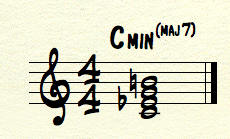
The Next Step
Look at your Jazz Melodic Minor Scale Sheet found in your
download file for this lesson.
Next, you are going to print out the file titled min(Maj7) Chord Changes found in the Lesson 9 File Folder that you downloaded at the start of the lesson. Be sure to download the correct file for your instrument Eb=Alto/Bari sax, Bb=tenor/soprano sax, C=Flute, guitar etc. Just like you did for the previous lessons.
Exercise 1: Playing The Root of Each Chord
You know the routine! Just like in Lesson 1, we are going to start by playing the root of each chord. This will get the sound of the progression in your head and under your fingers! Remember that you will be using the Jazz Melodic Minor for all of the following exercises.
Using the min(Maj7) Changes Sheet and the MP3 Play-a-long titled min(Maj7) Chord Progression, you are going to begin by just playing the root (1) of each chord. First you will play them as whole notes then you will improvise different rhythms using only the root of the chord.
Exercise 2: Playing pattern 12, 12, over each chord.
For exercise 2, we are going to be playing a pattern of 1,2 in eighth notes over each chord. It will look like this:
Exercise 3: Playing pattern 1232, 1232, over each chord.
Our pattern will look like this:
Play the above pattern over the entire chord progression and then improvise using only the
1232 pattern. After you have done the pattern, improvise using only those notes from the
pattern.
Exercise 4: Playing pattern 1235, 1235 over each chord.
For exercise 4, we are going to be playing a pattern of 1235, 1235 in eighth notes over each chord. It will look like this:
Play the above pattern over the entire chord progression and then improvise using only the
1235 pattern. After you have done the pattern, improvise using only those notes from the
pattern.
Exercise 5: Playing pattern 1357, 1357 over each chord.
For exercise 5, we are going to be playing a pattern of 1357, 1357 in eighth notes over each chord. It will look like this:
Play the above pattern over the entire chord progression and then improvise using only the
1357 pattern. After you have done the pattern, improvise using only those notes from the
pattern.
Exercise 6: Playing pattern 1357,6543 over each chord.
For exercise 6, we are going to be playing a pattern of 1357, 6543 in eighth notes over each chord. It will look like this:
Play the above pattern over the entire chord progression and then improvise using only the
1357,6543 pattern. After you have done the pattern, improvise using only those notes from the
pattern.
Exercise 7: Playing a Jazz Melodic Minor scale over each chord.
For exercise 7, we are going to be playing a Jazz Melodic Minor scale in eighth notes over each chord. It will look like this:
Play the above scale pattern over the entire chord progression.
Exercise 8: Starting To Improvise!
For exercise 8, we are actually going to being to improvise, but...with some restrictions. For this exercise, you are only going to be improvising using Quarter Notes.
Exercise 9: More Improvisation
For exercise 9, we are actually going to being to improvise, but...with some restrictions. For this exercise, you are only going to be improvising using only Eighth Notes.
Exercise 10: Improvise!!
For exercise 10, you can now improvise with no restrictions! Remember to keep it simple and know at all times where you are in the changes. You don’t need to play every note in the Jazz Melodic Minor scale for every chord! Also, be thinking about the key that you are playing in! This is VERY important, especially when we start moving ahead to other lessons!
This Concludes Lesson 9
Practicing Jazz Improvisation
Lesson 10
![]() To Lessons Page
To Lessons Page
Click Here To Download Lesson 10 Files
The files that you just downloaded will be used for this lesson. The folder contains several PDF Files that you may print out and an MP3 Play-a-long file.
Jazz Melodic Minor Mode II (The Dorian b2 Scale)
If we take our original C Jazz Melodic Minor Scale and start on the 2nd scale degree and play up one octave. We will be constructing a Dorian b2 Scale or Jazz Melodic Minor Mode II:
The above scale is called a D Dorian b2 Scale or Jazz Melodic Minor Mode II. Remember that you are still playing in the key of C Jazz Melodic Minor! You are just starting on the 2nd scale degree!
The above scale that can be used when improvising over a 7sus b9 chord. This chord is notated as follows:
The 7 sus b9 Chord
If we combine the 1, 4th, 5th, 7th and 9th of the above Jazz Melodic Minor Mode 2 scale we will now have
constructed a 7 sus b9 Chord. If you recall our last sus chord from lesson 8, the 3rd note of the scale was an avoid
note because you were playing a major 3rd against the 4th of the sus chord. In this case, you are playing a minor
3rd and it is no longer an avoid note. In fact, there are no avoid notes while playing in any of the Jazz Melodic Minor
Modes!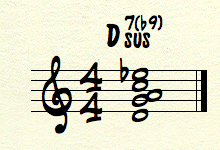
The Next Step
Look at your Jazz Melodic Minor Mode II Scale Sheet found in your
download file for this lesson.
Next, you are going to print out the file titled 7sus b9 Chord Changes found in the Lesson 10 File Folder that you downloaded at the start of the lesson. Be sure to download the correct file for your instrument Eb=Alto/Bari sax, Bb=tenor/soprano sax, C=Flute, guitar etc. Just like you did for the previous lessons.
Exercise 1: Playing The Root of Each Chord
You know the routine! Just like in Lesson 1, we are going to start by playing the root of each chord. This will get the sound of the progression in your head and under your fingers! Remember that you will be using the Jazz Melodic Minor Mode II for all of the following exercises.
Using the 7 sus b9 Changes Sheet and the MP3 Play-a-long titled 7 sus b9 Chord Progression, you are going to begin by just playing the root (1) of each chord. First you will play them as whole notes then you will improvise different rhythms using only the root of the chord.
Exercise 2: Playing pattern 12, 12, over each chord.
For exercise 2, we are going to be playing a pattern of 1,2 in eighth notes over each chord. It will look like this:
Exercise 3: Playing pattern 1232, 1232, over each chord.
Our pattern will look like this:
Play the above pattern over the entire chord progression and then improvise using only the
1232 pattern. After you have done the pattern, improvise using only those notes from the
pattern.
Exercise 4: Playing pattern 1235, 1235 over each chord.
For exercise 4, we are going to be playing a pattern of 1245, 1245 in eighth notes over each chord. It will look like this:
Play the above pattern over the entire chord progression and then improvise using only the
1235 pattern. After you have done the pattern, improvise using only those notes from the
pattern.
Exercise 5: Playing pattern 1457, 1457 over each chord.
For exercise 5, we are going to be playing a pattern of 1457, 1457 in eighth notes over each chord. It will look like this:
Play the above pattern over the entire chord progression and then improvise using only the
1457 pattern. After you have done the pattern, improvise using only those notes from the
pattern.
Exercise 6: Playing pattern 1457,6543 over each chord.
For exercise 6, we are going to be playing a pattern of 1457, 6543 in eighth notes over each chord. It will look like this:
Play the above pattern over the entire chord progression and then improvise using only the
1457,6543 pattern. After you have done the pattern, improvise using only those notes from the
pattern.
Exercise 7: Playing a Jazz Melodic Minor Mode II (Dorian b2) scale over each chord.
For exercise 7, we are going to be playing a Dorian b2 Scale scale in eighth notes over each chord. It will look like this:
Play the above scale pattern over the entire chord progression.
Exercise 8: Starting To Improvise!
For exercise 8, we are actually going to being to improvise, but...with some restrictions. For this exercise, you are only going to be improvising using Quarter Notes.
Exercise 9: More Improvisation
For exercise 9, we are actually going to being to improvise, but...with some restrictions. For this exercise, you are only going to be improvising using only Eighth Notes.
Exercise 10: Improvise!!
For exercise 10, you can now improvise with no restrictions! Remember to keep it simple and know at all times where you are in the changes. You don’t need to play every note in the Jazz Melodic Minor scale for every chord! Remember to not sit on the 3rd note of the scale as it is not a chord tone. The fourth is a much better resting place! Also, be thinking about the key that you are playing in! This is VERY important, especially when we start moving ahead to other lessons!
This Concludes Lesson 10
Practicing Jazz Improvisation
Lesson 11
Click Here To Download Lesson 11 Files
The files that you just downloaded will be used for this lesson. The folder contains several PDF Files that you may print out and an MP3 Play-a-long file.
Jazz Melodic Minor Mode III (The Lydian Augmented Scale)
If we take our original C Jazz Melodic Minor Scale and start on the 3rd scale degree and play up one octave. We will be constructing a Lydian Augmented Scale or Jazz Melodic Minor Mode III:
The above scale is called an Eb Lydian Augmented Scale or Jazz Melodic Minor Mode III. Remember that you are still playing in the key of C Jazz Melodic Minor! You are just starting on the 3rd scale degree!
The above scale that can be used when improvising over a Maj7 #5 chord. This chord is notated as follows:
The Maj 7 #5 Chord
If we combine the 1, 3rd, 5th and 7th notes of the above Jazz Melodic Minor scale we will now have
constructed a Maj7 (#5) chord: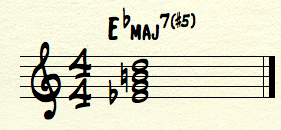
The Next Step
Look at your Jazz Melodic Minor Mode III Scale Sheet found in your download file for this lesson.
Next, you are going to print out the file titled Maj7 #5 Chord Changes found in the Lesson 11 File Folder that you downloaded at the start of the lesson. Be sure to download the correct file for your instrument Eb=Alto/Bari sax, Bb=tenor/soprano sax, C=Flute, guitar etc. Just like you did for the previous lessons.
Exercise 1: Playing The Root of Each Chord
You know the routine! Just like in Lesson 1, we are going to start by playing the root of each chord. This will get the sound of the progression in your head and under your fingers! Remember that you will be using the Jazz Melodic Minor Mode III for all of the following exercises.
Using the Maj7 #5 Changes Sheet and the MP3 Play-a-long titled Maj7 #5 Chord Progression, you are going to begin by just playing the root (1) of each chord. First you will play them as whole notes then you will improvise different rhythms using only the root of the chord.
Exercise 2: Playing pattern 12, 12, over each chord.
For exercise 2, we are going to be playing a pattern of 1,2 in eighth notes over each chord. It will look like this:
Exercise 3: Playing pattern 1232, 1232, over each chord.
Our pattern will look like this:
Play the above pattern over the entire chord progression and then improvise using only the
1232 pattern. After you have done the pattern, improvise using only those notes from the
pattern.
Exercise 4: Playing pattern 1235, 1235 over each chord.
For exercise 4, we are going to be playing a pattern of 1235, 1235 in eighth notes over each chord. It will look like this:
Play the above pattern over the entire chord progression and then improvise using only the
1235 pattern. After you have done the pattern, improvise using only those notes from the
pattern.
Exercise 5: Playing pattern 1357, 1357 over each chord.
For exercise 5, we are going to be playing a pattern of 1357, 1357 in eighth notes over each chord. It will look like this:
Play the above pattern over the entire chord progression and then improvise using only the
1357 pattern. After you have done the pattern, improvise using only those notes from the
pattern.
Exercise 6: Playing pattern 1357,6543 over each chord.
For exercise 6, we are going to be playing a pattern of 1357, 6543 in eighth notes over each chord. It will look like this:
Play the above pattern over the entire chord progression and then improvise using only the
1357,6543 pattern. After you have done the pattern, improvise using only those notes from the
pattern.
Exercise 7: Playing a Jazz Melodic Minor Mode III scale over each chord.
For exercise 7, we are going to be playing a Lydian Augmented scale in eighth notes over each chord. It will look like this:
Play the above scale pattern over the entire chord progression.
Exercise 8: Starting To Improvise!
For exercise 8, we are actually going to being to improvise, but...with some restrictions. For this exercise, you are only going to be improvising using Quarter Notes.
Exercise 9: More Improvisation
For exercise 9, we are actually going to being to improvise, but...with some restrictions. For this exercise, you are only going to be improvising using only Eighth Notes.
Exercise 10: Improvise!!
For exercise 10, you can now improvise with no restrictions! Remember to keep it simple and know at all times where you are in the changes. You don’t need to play every note in the Jazz Melodic Minor scale for every chord! Also, be thinking about the key that you are playing in! This is VERY important, especially when we start moving ahead to other lessons!
This Concludes Lesson 11
Practicing Jazz Improvisation
Lesson 12
Click Here To Download Lesson 12 Files
The files that you just downloaded will be used for this lesson. The folder contains several PDF Files that you may print out and an MP3 Play-a-long file.
Jazz Melodic Minor Mode IV (The Lydian Dominant Scale)
If we take our original C Jazz Melodic Minor Scale and start on the 4th scale degree and play up one octave. We will be constructing a Lydian Dominant Scale or Jazz Melodic Minor Mode IV:
The above scale is called an F Lydian Dominant Scale or Jazz Melodic Minor Mode IV. Remember that you are still playing in the key of C Jazz Melodic Minor! You are just starting on the 4th scale degree!
The above scale that can be used when improvising over a 7#11 chord. This chord is notated as follows:
The 7 (#11) Chord
If we combine the 1, 3rd, 5th, 7th, 9th, and 11th notes of the above Jazz Melodic Minor scale we will now have
constructed a 7 (#11) chord: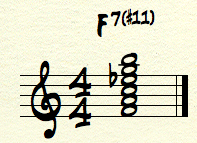
The Next Step
Look at your Jazz Melodic Minor Mode IV Scale Sheet found in your download file for this lesson.
Next, you are going to print out the file titled 7(#11) Chord Changes found in the Lesson 12 File Folder that you downloaded at the start of the lesson. Be sure to download the correct file for your instrument Eb=Alto/Bari sax, Bb=tenor/soprano sax, C=Flute, guitar etc. Just like you did for the previous lessons.
Exercise 1: Playing The Root of Each Chord
You know the routine! Just like in Lesson 1, we are going to start by playing the root of each chord. This will get the sound of the progression in your head and under your fingers! Remember that you will be using the Jazz Melodic Minor Mode IV for all of the following exercises.
Using the 7(#11) Changes Sheet and the MP3 Play-a-long titled 7(#11) Chord Progression, you are going to begin by just playing the root (1) of each chord. First you will play them as whole notes then you will improvise different rhythms using only the root of the chord.
Exercise 2: Playing pattern 12, 12, over each chord.
For exercise 2, we are going to be playing a pattern of 1,2 in eighth notes over each chord. It will look like this:
Exercise 3: Playing pattern 1232, 1232, over each chord.
Our pattern will look like this:
Play the above pattern over the entire chord progression and then improvise using only the
1232 pattern. After you have done the pattern, improvise using only those notes from the
pattern.
Exercise 4: Playing pattern 1235, 1235 over each chord.
For exercise 4, we are going to be playing a pattern of 1235, 1235 in eighth notes over each chord. It will look like this:
Play the above pattern over the entire chord progression and then improvise using only the
1235 pattern. After you have done the pattern, improvise using only those notes from the
pattern.
Exercise 5: Playing pattern 1357, 1357 over each chord.
For exercise 5, we are going to be playing a pattern of 1357, 1357 in eighth notes over each chord. It will look like this:
Play the above pattern over the entire chord progression and then improvise using only the
1357 pattern. After you have done the pattern, improvise using only those notes from the
pattern.
Exercise 6: Playing pattern 1357,6543 over each chord.
For exercise 6, we are going to be playing a pattern of 1357, 6543 in eighth notes over each chord. It will look like this:
Play the above pattern over the entire chord progression and then improvise using only the
1357,6543 pattern. After you have done the pattern, improvise using only those notes from the
pattern.
Exercise 7: Playing a Jazz Melodic Minor Mode IV scale over each chord.
For exercise 7, we are going to be playing a Lydian Dominant scale in eighth notes over each chord. It will look like this:
Play the above scale pattern over the entire chord progression.
Exercise 8: Starting To Improvise!
For exercise 8, we are actually going to being to improvise, but...with some restrictions. For this exercise, you are only going to be improvising using Quarter Notes.
Exercise 9: More Improvisation
For exercise 9, we are actually going to being to improvise, but...with some restrictions. For this exercise, you are only going to be improvising using only Eighth Notes.
Exercise 10: Improvise!!
For exercise 10, you can now improvise with no restrictions! Remember to keep it simple and know at all times where you are in the changes. You don’t need to play every note in the Jazz Melodic Minor scale for every chord! Also, be thinking about the key that you are playing in! This is VERY important, especially when we start moving ahead to other lessons!
This Concludes Lesson 12
Practicing Jazz Improvisation
Lesson 13
Click Here To Download Lesson 13 Files
The files that you just downloaded will be used for this lesson. The folder contains several PDF Files that you may print out and an MP3 Play-a-long file.
Jazz Melodic Minor Mode V (The Mixolydian b6 Scale)
If we take our original C Jazz Melodic Minor Scale and start on the 5th scale degree and play up one octave. We will be constructing a Mixolydian b6 scale or Jazz Melodic Minor Mode V:
The above scale is called a G Mixolydian b6 Scale or Jazz Melodic Minor Mode V. Remember that you are still playing in the key of C Jazz Melodic Minor! You are just starting on the 5th scale degree!
The above scale that can be used when improvising over a min(Maj7)/ chord. This chord is notated as follows:
The min (Maj7)/ Chord
If we combine the 5th, root, 3rd, 5th, and 7th notes of the above Jazz Melodic Minor scale we will now have
constructed a min (Maj7)/ chord: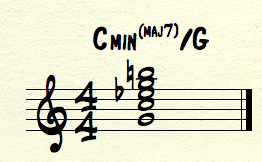
Notice that this chord contains a G in the root of the chord. This tells us that there is an alternate bass note.
In this case the pianist would be playing a C min (Maj7) chord and the bass player would be playing a G bass,
the 5th of the chord.
The Next Step
Look at your Jazz Melodic Minor Mode V Scale Sheet found in your download file for this lesson.
Next, you are going to print out the file titled min(Maj7)/ Chord Changes found in the Lesson 13 File Folder that you downloaded at the start of the lesson. Be sure to download the correct file for your instrument Eb=Alto/Bari sax, Bb=tenor/soprano sax, C=Flute, guitar etc. Just like you did for the previous lessons.
Exercise 1: Playing The Root of Each Chord
You know the routine! Just like in Lesson 1, we are going to start by playing the root of each chord. This will get the sound of the progression in your head and under your fingers! Remember that you will be using the Jazz Melodic Minor Mode V for all of the following exercises.
Using the min(Maj7)/ Changes Sheet and the MP3 Play-a-long titled min(Maj7)/ Chord Progression, you are going to begin by just playing the root (1) of each chord. First you will play them as whole notes then you will improvise different rhythms using only the root of the chord.
Exercise 2: Playing pattern 12, 12, over each chord.
For exercise 2, we are going to be playing a pattern of 1,2 in eighth notes over each chord. It will look like this:
Exercise 3: Playing pattern 1232, 1232, over each chord.
Our pattern will look like this:
Play the above pattern over the entire chord progression and then improvise using only the
1232 pattern. After you have done the pattern, improvise using only those notes from the
pattern.
Exercise 4: Playing pattern 1235, 1235 over each chord.
For exercise 4, we are going to be playing a pattern of 1235, 1235 in eighth notes over each chord. It will look like this:
Play the above pattern over the entire chord progression and then improvise using only the
1235 pattern. After you have done the pattern, improvise using only those notes from the
pattern.
Exercise 5: Playing pattern 1357, 1357 over each chord.
For exercise 5, we are going to be playing a pattern of 1357, 1357 in eighth notes over each chord. It will look like this:
Play the above pattern over the entire chord progression and then improvise using only the
1357 pattern. After you have done the pattern, improvise using only those notes from the
pattern.
Exercise 6: Playing pattern 1357,6543 over each chord.
For exercise 6, we are going to be playing a pattern of 1357, 6543 in eighth notes over each chord. It will look like this:
Play the above pattern over the entire chord progression and then improvise using only the
1357,6543 pattern. After you have done the pattern, improvise using only those notes from the
pattern.
Exercise 7: Playing a Jazz Melodic Minor Mode V scale over each chord.
For exercise 7, we are going to be playing a Mixolydian b6 scale in eighth notes over each chord. It will look like this:
Play the above scale pattern over the entire chord progression.
Exercise 8: Starting To Improvise!
For exercise 8, we are actually going to being to improvise, but...with some restrictions. For this exercise, you are only going to be improvising using Quarter Notes.
Exercise 9: More Improvisation
For exercise 9, we are actually going to being to improvise, but...with some restrictions. For this exercise, you are only going to be improvising using only Eighth Notes.
Exercise 10: Improvise!!
For exercise 10, you can now improvise with no restrictions! Remember to keep it simple and know at all times where you are in the changes. You don’t need to play every note in the Jazz Melodic Minor scale for every chord! Also, be thinking about the key that you are playing in! This is VERY important, especially when we start moving ahead to other lessons!
This Concludes Lesson 13
Practicing Jazz Improvisation
Lesson 14
Click Here To Download Lesson 14 Files
The files that you just downloaded will be used for this lesson. The folder contains several PDF Files that you may print out and an MP3 Play-a-long file.
Jazz Melodic Minor Mode VI (The Half Diminished Locrian #2 Scale)
If we take our original C Jazz Melodic Minor Scale and start on the 6th scale degree and play up one octave. We will be constructing a Half Diminished Locrian #2 scale or Jazz Melodic Minor Mode VI:
The above scale is called a Half Diminished Locrian #2 Scale or Jazz Melodic Minor Mode VI. Remember that you are still playing in the key of C Jazz Melodic Minor! You are just starting on the 6th scale degree!
The above scale that can be used when improvising over a min7 b5 chord. This chord is notated as follows: (Note that we also had this chord in Lesson 5. This is just another scale that you can use with the min7 b5 chord) Remember that this chord can be notated two ways:
![]()
The min7 b5 Chord
If we combine the root, 3rd, 5th, and 7th notes of the above Jazz Melodic Minor scale we will now have
constructed a min7 b5 chord: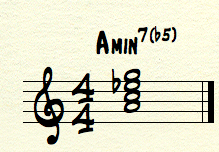
The Next Step
Look at your Jazz Melodic Minor Mode VI Scale Sheet found in your download file for this lesson.
Next, you are going to print out the file titled m7b5 Chord Changes found in the Lesson 14 File Folder that you downloaded at the start of the lesson. Be sure to download the correct file for your instrument Eb=Alto/Bari sax, Bb=tenor/soprano sax, C=Flute, guitar etc. Just like you did for the previous lessons.
Exercise 1: Playing The Root of Each Chord
You know the routine! Just like in Lesson 1, we are going to start by playing the root of each chord. This will get the sound of the progression in your head and under your fingers! Remember that you will be using the Jazz Melodic Minor Mode VI for all of the following exercises.
Using the 7b5 Changes Sheet and the MP3 Play-a-long titled m7b5 Chord Progression, you are going to begin by just playing the root (1) of each chord. First you will play them as whole notes then you will improvise different rhythms using only the root of the chord.
Exercise 2: Playing pattern 12, 12, over each chord.
For exercise 2, we are going to be playing a pattern of 1,2 in eighth notes over each chord. It will look like this:
Exercise 3: Playing pattern 1232, 1232, over each chord.
Our pattern will look like this:
Play the above pattern over the entire chord progression and then improvise using only the
1232 pattern. After you have done the pattern, improvise using only those notes from the
pattern.
Exercise 4: Playing pattern 1235, 1235 over each chord.
For exercise 4, we are going to be playing a pattern of 1235, 1235 in eighth notes over each chord. It will look like this:
Play the above pattern over the entire chord progression and then improvise using only the
1235 pattern. After you have done the pattern, improvise using only those notes from the
pattern.
Exercise 5: Playing pattern 1357, 1357 over each chord.
For exercise 5, we are going to be playing a pattern of 1357, 1357 in eighth notes over each chord. It will look like this:
Play the above pattern over the entire chord progression and then improvise using only the
1357 pattern. After you have done the pattern, improvise using only those notes from the
pattern.
Exercise 6: Playing pattern 1357,6543 over each chord.
For exercise 6, we are going to be playing a pattern of 1357, 6543 in eighth notes over each chord. It will look like this:
Play the above pattern over the entire chord progression and then improvise using only the
1357,6543 pattern. After you have done the pattern, improvise using only those notes from the
pattern.
Exercise 7: Playing a Jazz Melodic Minor Mode VI scale over each chord.
For exercise 7, we are going to be playing a Half Diminished Locrian #2 scale in eighth notes over each chord. It will look like this:
Play the above scale pattern over the entire chord progression.
Exercise 8: Starting To Improvise!
For exercise 8, we are actually going to being to improvise, but...with some restrictions. For this exercise, you are only going to be improvising using Quarter Notes.
Exercise 9: More Improvisation
For exercise 9, we are actually going to being to improvise, but...with some restrictions. For this exercise, you are only going to be improvising using only Eighth Notes.
Exercise 10: Improvise!!
For exercise 10, you can now improvise with no restrictions! Remember to keep it simple and know at all times where you are in the changes. You don’t need to play every note in the Jazz Melodic Minor scale for every chord! Also, be thinking about the key that you are playing in! This is VERY important, especially when we start moving ahead to other lessons!
This Concludes Lesson 14
Practicing Jazz Improvisation
Lesson 15
Click Here To Download Lesson 15 Files
The files that you just downloaded will be used for this lesson. The folder contains several PDF Files that you may print out and an MP3 Play-a-long file.
Jazz Melodic Minor Mode VII (The Altered or Diminished Whole Tone Scale)
If we take our original C Jazz Melodic Minor Scale and start on the 7th scale degree and play up one octave. We will be constructing an Altered scale or Jazz Melodic Minor Mode VII:
The above scale is called a B Altered Scale or Jazz Melodic Minor Mode VII. Remember that you are still playing in the key of C Jazz Melodic Minor! You are just starting on the 7th scale degree! Note that I have also labeled the altered tones that are contained within the scale.
This scale is a little different, in that it can be used over ANY Dominant 7 chord that contains an altered tone! This includes the following chords:
7b9, 7#9, 9#11, 7b5, 7#11b13, 7#5, 7alt.
In short, ANY Dominant 7 chord that contains one, or more, of the following altered tones:
b9
#9
#11
b5 or #4
b13
#5
or, a combination of any of the above!
For the sake of this lesson we are going to call this chord an alt chord:
The Alt Chord
If we combine the following notes of the above Jazz Melodic Minor scale we will now have
constructed an Altered chord: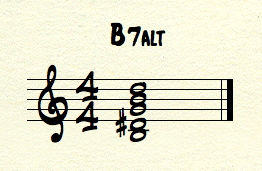
The Next Step
Look at your Altered Scale Sheet found in your download file for this lesson.
Next, you are going to print out the file titled Altered Chord Changes found in the Lesson 15 File Folder that you downloaded at the start of the lesson. Be sure to download the correct file for your instrument Eb=Alto/Bari sax, Bb=tenor/soprano sax, C=Flute, guitar etc. Just like you did for the previous lessons.
Exercise 1: Playing The Root of Each Chord
You know the routine! Just like in Lesson 1, we are going to start by playing the root of each chord. This will get the sound of the progression in your head and under your fingers! Remember that you will be using the Jazz Melodic Minor Mode VII for all of the following exercises.
Using the Altered Chord Changes Sheet and the MP3 Play-a-long titled Altered Chord Progression, you are going to begin by just playing the root (1) of each chord. First you will play them as whole notes then you will improvise different rhythms using only the root of the chord.
Exercise 2: Playing pattern 12, 12, over each chord.
For exercise 2, we are going to be playing a pattern of 1,2 in eighth notes over each chord. It will look like this:
Exercise 3: Playing pattern 1232, 1232, over each chord.
Our pattern will look like this:
Play the above pattern over the entire chord progression and then improvise using only the
1232 pattern. After you have done the pattern, improvise using only those notes from the
pattern.
Exercise 4: Playing pattern 1235, 1235 over each chord.
For exercise 4, we are going to be playing a pattern of 1235, 1235 in eighth notes over each chord. It will look like this:
Play the above pattern over the entire chord progression and then improvise using only the
1235 pattern. After you have done the pattern, improvise using only those notes from the
pattern.
Exercise 5: Playing pattern 1357, 1357 over each chord.
For exercise 5, we are going to be playing a pattern of 1357, 1357 in eighth notes over each chord. It will look like this:
Play the above pattern over the entire chord progression and then improvise using only the
1357 pattern. After you have done the pattern, improvise using only those notes from the
pattern.
Exercise 6: Playing pattern 1357,6543 over each chord.
For exercise 6, we are going to be playing a pattern of 1357, 6543 in eighth notes over each chord. It will look like this:
Play the above pattern over the entire chord progression and then improvise using only the
1357,6543 pattern. After you have done the pattern, improvise using only those notes from the
pattern.
Exercise 7: Playing a Jazz Melodic Minor Mode VII scale over each chord.
For exercise 7, we are going to be playing an Altered scale in eighth notes over each chord. It will look like this:
Play the above scale pattern over the entire chord progression.
Exercise 8: Starting To Improvise!
For exercise 8, we are actually going to being to improvise, but...with some restrictions. For this exercise, you are only going to be improvising using Quarter Notes.
Exercise 9: More Improvisation
For exercise 9, we are actually going to being to improvise, but...with some restrictions. For this exercise, you are only going to be improvising using only Eighth Notes.
Exercise 10: Improvise!!
For exercise 10, you can now improvise with no restrictions! Remember to keep it simple and know at all times where you are in the changes. You don’t need to play every note in the Jazz Melodic Minor scale for every chord! Also, be thinking about the key that you are playing in! This is VERY important, especially when we start moving ahead to other lessons!
This concludes our study of the Jazz Melodic Minor Modes! In the download folder for this lesson I have included a Jazz Melodic Minor Mode sheet for you to use as a reference. Print it out and refer to it when you are doing your chord/scale analysis.
In our next lesson we will be studying the Diminished chord and scale!
Real Book Tunes
Get The Real Book I Sixth Edition (Available on Amazon) and look at the following tune:
Blue Trane Pg. 54.
This tune contains mostly 7#9 chords, which fit into our Altered scale category. Be sure to study the chord/scale analysis for this tune.
This Concludes Lesson 15
Practicing Jazz Improvisation
Lesson 16
![]() To Lessons Page
To Lessons Page
Click Here To Download Lesson 16 Files
The files that you just downloaded will be used for this lesson. The folder contains several PDF Files that you may print out and an MP3 Play-a-long file.
The Diminished, Octatonic, or Half-Step Whole-Step Scale.
This scale is constructed by alternating half-steps and whole steps. It is a bit strange in that it is an eight-note scale. It is also interesting in that there are only three Diminished scales. After that, they just start repeating. Study the three scales below and then study and memorize each of the diminished scales on your Diminished Scale Sheet that you downloaded for this lesson.


You can use a Diminished Scale with a Diminished or Diminished 7 chord, which can be notated as follows:
![]()
 or
or 

The Diminished Chord
If we combine the 1st, 3rd, and 5th notes of a C Diminished Scale, we will have a Diminished
Triad. Notice that the chord is constructed of all minor thirds!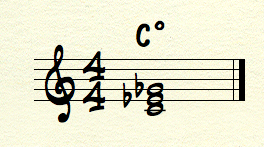
If we combine the 1st, 3rd, 5th, and 7th notes of a C Diminished Scale, we will have a Diminished
7 Chord. Notice that the chord is constructed of all minor thirds! Also, notice that the 7th note of the scale
is A-natural, and the 7th of the chord is a B-double-flat (the enharmonic equal to A-natural).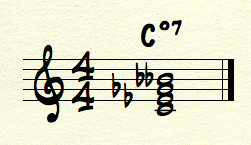
The Next Step
Look at your Diminished Scale Sheet found in your download file for this lesson.
Next, you are going to print out the file titled Diminished Chord Changes found in the Lesson 16 File Folder that you downloaded at the start of the lesson. Be sure to download the correct file for your instrument Eb=Alto/Bari sax, Bb=tenor/soprano sax, C=Flute, guitar etc. Just like you did for the previous lessons.
Exercise 1: Playing The Root of Each Chord
You know the routine! Just like in Lesson 1, we are going to start by playing the root of each chord. This will get the sound of the progression in your head and under your fingers!
Using the Diminished Chord Changes Sheet and the MP3 Play-a-long titled Diminished Chord Progression, you are going to begin by just playing the root (1) of each chord. First you will play them as whole notes then you will improvise different rhythms using only the root of the chord.
Exercise 2: Playing pattern 12, 12, over each chord.
For exercise 2, we are going to be playing a pattern of 1,2 in eighth notes over each chord. It will look like this:
Exercise 3: Playing pattern 1232, 1232, over each chord.
Our pattern will look like this:
Play the above pattern over the entire chord progression and then improvise using only the
1232 pattern. After you have done the pattern, improvise using only those notes from the
pattern.
Exercise 4: Playing pattern 1235, 1235 over each chord.
For exercise 4, we are going to be playing a pattern of 1235, 1235 in eighth notes over each chord. It will look like this:
Play the above pattern over the entire chord progression and then improvise using only the
1235 pattern. After you have done the pattern, improvise using only those notes from the
pattern.
Exercise 5: Playing pattern 1357, 1357 over each chord.
For exercise 5, we are going to be playing a pattern of 1357, 1357 in eighth notes over each chord. It will look like this:
Play the above pattern over the entire chord progression and then improvise using only the
1357 pattern. After you have done the pattern, improvise using only those notes from the
pattern.
Exercise 6: Playing pattern 1357,6543 over each chord.
For exercise 6, we are going to be playing a pattern of 1357, 6543 in eighth notes over each chord. It will look like this:
Play the above pattern over the entire chord progression and then improvise using only the
1357,6543 pattern. After you have done the pattern, improvise using only those notes from the
pattern.
Exercise 7: Playing a Diminished scale over each chord.
For exercise 7, we are going to be playing a Diminished scale in eighth notes over each chord. It will look like this:
Play the above scale pattern over the entire chord progression.
Exercise 8: Starting To Improvise!
For exercise 8, we are actually going to being to improvise, but...with some restrictions. For this exercise, you are only going to be improvising using Quarter Notes.
Exercise 9: More Improvisation
For exercise 9, we are actually going to being to improvise, but...with some restrictions. For this exercise, you are only going to be improvising using only Eighth Notes.
Exercise 10: Improvise!!
For exercise 10, you can now improvise with no restrictions! Remember to keep it simple and know at all times where you are in the changes. You don’t need to play every note in the Diminished scale for every chord! Also, be thinking about the key that you are playing in! This is VERY important, especially when we start moving ahead to other lessons!
Real Book Tunes
Get The Real Book I Sixth Edition (Available on Amazon) and look at the following tune:
Have You Met Miss Jones Pg. 172
This tune combines all of the concepts that we have learned so far and also contains a diminished 7 Chord!
This Concludes Lesson 16
Practicing Jazz Improvisation
Lesson 17
Click Here To Download Lesson 17 Files
The files that you just downloaded will be used for this lesson. The folder contains several PDF Files that you may print out and an MP3 Play-a-long file.
The Whole Tone Scale and the Augmented 7 Chord
This scale is constructed of all whole steps. It is a seven note scale! Memorize each of the Whole Tone scales on your Whole Tone Scale Sheet that you downloaded for this lesson.
You can use a Whole Tone Scale with an Augmented or Augmented 7 chord, which can be notated as follows:

 or
or 

The Augmented Chord
If we combine the 1st, 3rd, and 5th notes of a C Whole Tone Scale, we will have an Augmented
Triad. Notice that the chord is constructed of all Major thirds!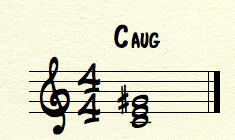
If we combine the 1st, 3rd, 5th, and 7th notes of a C Whole Tone Scale, we will have an Augmented
7 Chord. Notice that the 6th note of the scale
is A#, and the 7th of the chord is a Bb (the enharmonic equal to A#).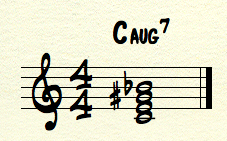
The Next Step
Look at your Whole Tone Scale Sheet found in your download file for this lesson.
Next, you are going to print out the file titled Augmented Chord Changes found in the Lesson 17 File Folder that you downloaded at the start of the lesson. Be sure to download the correct file for your instrument Eb=Alto/Bari sax, Bb=tenor/soprano sax, C=Flute, guitar etc. Just like you did for the previous lessons.
Exercise 1: Playing The Root of Each Chord
You know the routine! Just like in Lesson 1, we are going to start by playing the root of each chord. This will get the sound of the progression in your head and under your fingers!
Using the Augmented 7 Chord Changes Sheet and the MP3 Play-a-long titled Augmented 7 Chord Progression, you are going to begin by just playing the root (1) of each chord. First you will play them as whole notes then you will improvise different rhythms using only the root of the chord.
Exercise 2: Playing pattern 12, 12, over each chord.
For exercise 2, we are going to be playing a pattern of 1,2 in eighth notes over each chord. It will look like this:
Exercise 3: Playing pattern 1232, 1232, over each chord.
Our pattern will look like this:
Play the above pattern over the entire chord progression and then improvise using only the
1232 pattern. After you have done the pattern, improvise using only those notes from the
pattern.
Exercise 4: Playing pattern 1235, 1235 over each chord.
For exercise 4, we are going to be playing a pattern of 1235, 1235 in eighth notes over each chord. It will look like this:
Play the above pattern over the entire chord progression and then improvise using only the
1235 pattern. After you have done the pattern, improvise using only those notes from the
pattern.
Exercise 5: Playing pattern 1357, 1357 over each chord.
For exercise 5, we are going to be playing a pattern of 1357, 1357 in eighth notes over each chord. It will look like this:
Play the above pattern over the entire chord progression and then improvise using only the
1357 pattern. After you have done the pattern, improvise using only those notes from the
pattern.
Exercise 6: Playing pattern 1357,7543 over each chord.
For exercise 6, we are going to be playing a pattern of 1357, 7543 in eighth notes over each chord. It will look like this:
Play the above pattern over the entire chord progression and then improvise using only the
1357,7543 pattern. After you have done the pattern, improvise using only those notes from the
pattern.
Exercise 7: Playing a Whole Tone scale over each chord.
For exercise 7, we are going to be playing a Whole Tone scale in eighth notes over each chord. It will look like this:
Play the above scale pattern over the entire chord progression.
Exercise 8: Starting To Improvise!
For exercise 8, we are actually going to being to improvise, but...with some restrictions. For this exercise, you are only going to be improvising using Quarter Notes.
Exercise 9: More Improvisation
For exercise 9, we are actually going to being to improvise, but...with some restrictions. For this exercise, you are only going to be improvising using only Eighth Notes.
Exercise 10: Improvise!!
For exercise 10, you can now improvise with no restrictions! Remember to keep it simple and know at all times where you are in the changes. You don’t need to play every note in the Whole Tone scale for every chord! Also, be thinking about the key that you are playing in! This is VERY important, especially when we start moving ahead to other lessons!
Congratulations! You have now learned enough material to be able to improvise on just about any tune from the jazz or pop genre!
Remember when you approach playing a new tune to first start out by analyzing the key centers to that tune, and then doing the 10 exercises that you learned from the above lessons. This will help you to get the tune in your ears and under your fingers! The exercises will also help you to memorize the tune much faster!
Please check back to this site often as I will be adding more Play-a-longs from the Real Book with chord scale analysis.
If you have any questions or comments please contact me! I love feedback from students!
I hope that this course has helped you to become a better improvisor!
Best,
Rik Pfenninger